![]()
May
Flower
Harp
Guitars
by Gregg Miner
Updated June, 2019
| There are plenty of
Chicago instrument manufacturers with extremely convoluted histories...perhaps
none more so than H. J. Flower, who either - A) Produced B) Distributed C) Imported D) All of the above - his personal "May Flower" brand of bowl back mandolins around the 1900's. I'll explore that as much as I can below, but of course, I'm here to talk about harp guitars. |
|
| I was more than a little excited when
historian Jim Garber sent images of a rare 1901 May Flower catalog - as
"and Harp Guitars" was boldly announced on the cover.NOTE
1 Even more so when I discovered several harp
guitar images contained within. Unfortunately, none of them were, in
fact, May Flower instruments!
|
|
The first one we see is a fascinating specimen on an
artist's endorsement page - none other than our old friend Signor
Calamara from the 1899 Bohmann catalog.
The text states:
This seems to imply that Calamara traded in his Bohmann instrument for a May Flower, presumably the one he is holding. The line "Harp-Guitars Made to Order" at page bottom certainly reinforces this belief. But
is it a May Flower harp guitar? And if so, who built it? While Calamara
biographer Sheri Crawford Mignano writes that Emilio did indeed abandon
Bohmann at this time, we can’t be certain. However, she is undoubtedly
right in assuming that the egotistical Bohmann probably would never have
forgiven Calamara for endorsing another’s instruments, and Calamara is
here recommending May Flower mandolins to all his students (Calamara
taught all the American fretted string instruments). |
|
| Unfortunately, we don’t even know for sure who built the early May Flower mandolins, though Harry Flower’s future partner Andrew Groehsl (and his staff) is one idea (Groehsl’s would go on to head Stromberg-Voisinet, then the Kay Musical Instrument Company). The harp guitar has a couple features reminiscent of Bohmann, with a slotted headstock typical of the Larson brothers (also of Chicago). Experts say it is neither (I would agree). Most intriguing are the sloped “cutaway” shoulders – something Bohmann would become well known for…but not for many years! (See the final specimens at the bottom of The Harp Guitars of Joseph Bohmann.). Were the sloped shoulders for better access to the high frets an idea of Calamara’s? Note that Calamara requested – and this time fully strung – a full twelve chromatic sub-bass strings. | |
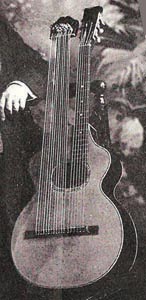 |
The Calamara May Flower harp guitar compared to an obviously-larger Bohmann Contra Bass Harp Guitar of this period and Calamara’s own custom Bohmann CBHG. For the full Calamara story, please see Emilio and Emily Calamara: A Tale of Two Musicians. |
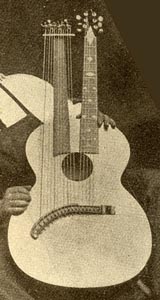 |
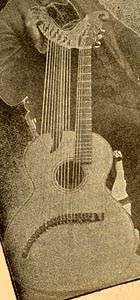
|
| A second image in the May Flower catalog containing three harp guitars is another mystery – as the identical group appeared in Bohmann’s catalog! We’ve seen multiple names for the same group in Bohmann’s catalog, and the same seems to be the case here. Perhaps both are right, and these same members belonged to both groups – or perhaps the “Steinway Mandolin Orchestra” simply changed its name? What’s certain is that, while the seating positions have re-arranged, the exact same gentleman appear in each image against the same studio backdrop, photographed during one session. | |
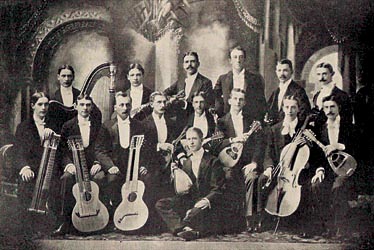 Edgar A. Benson's Celebrated Mandolin Orchestra, Chicago, Ill. from the 1901 May Flower catalog. |
 The Steinway Mandolin Orchestra from the 1899 Bohmann catalog. |
|
In
the Bohmann catalog, this group supposedly used all Bohmanns. Now they
"use and recommend the May Flower mandolin"?! What is going
on? Why would Flower use the same Bohmann image? Could Bohmann have
possibly made mandolins for H. J. Flower? There
is no implication that these harp guitars are "May Flower"
brand instruments, which is just as well. So we are left with my
original speculations on these three instruments discussed in The
Harp Guitars of Joseph Bohmann. |
|
| By now you should be saying, "OK, so wait a minute - I thought this article was called "May Flower Harp Guitars!" | |
| True enough - I've kind of led you on. The speculation
about the harp guitars in the May Flower catalog went nowhere - they aren't
May Flower harp guitars, despite the Catalog cover's promise. Luckily, I
had an ace up my sleeve - an actual labeled May Flower harp guitar
specimen (so at least once they made good on their promise to fill custom
orders).
Pictured in the Form 2a Gallery, this instrument, the only May Flower yet discovered, is owned by harp guitar enthusiast David Jorgensen, who brought it to the 2nd Harp Guitar Gathering where I photographed it, and Larson expert Robert Hartman examined it. Bob and others have previously stated the belief that some or all guitars and mandolins marked May Flower that were built between 1900 and 1910 were built by the Larson brothers. This instrument has design similarities (especially the "Stauffer-style" bass headstock) as two other suspected Larson-built Chicago brands - Meyers and Leland. So, in this case, we seem to have a Larson-built May Flower brand harp guitar; in the catalog above, we have a possible Bohmann connection, or simply the announced ability to custom build "May Flower" harp guitars. Built by whom is the question. |
|
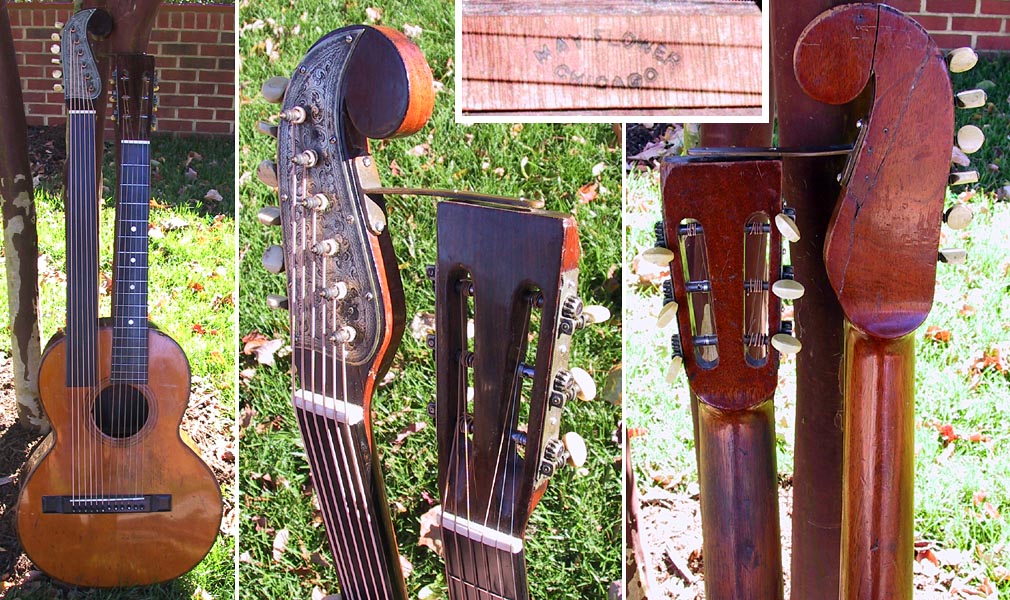
| ......May, herself.
The "May Flower" line of mandolins, mandolas and guitars was named after Harry Flower's daughter May. At right, from the back of the 1901 catalog, May poses with her namesake mandolin (looking like she wants to beat her father over the head with it). Provenance of May Flower instruments is hard to decipher for several reasons. One, Harry Flower put his name on a couple of different, related companies, whose history is still unclear. Two, the name was licensed to Lyon & Healy and likely others, such as the Wurlitzer company, besides being applied to Flower's own instruments built by persons or factories unknown. Three, the name has permutated into several spellings, that may or may not be related to the date, responsible company or builder. These are: |
|
Michael Holmes' Mugwumps Encyclopedia of American Fretted Instrument Makers lists the following Flower entries:
Holmes also provided me with further details: "He (Harry) opened Mayflower Music, a retail shop, in 1900 in partnership with W. H. Austin. In January, 1904 Flower announced a line of instruments named for his daughter May, that he would sell direct to dealers, but by February the agency for their distribution had been placed with JOSEPH W. STERN & CO. In 1905, "Mayflower" was all one word. One circa 1910 Mayflower guitar has been reported with a label marked "Flower & Groeschl." In 1912 LYON & HEALY announced that they had obtained the sole rights to the name and distribution of Mayflower mandolins and guitars. Later, in the 1920s, STROMBERG-VOISINET advertised a line of Mayflower instruments." |
|
To the Mugwumps listing, I would add "c.1897 to c.1910" to the third entry, as the 1901 catalog demonstrates that the brand was started at least that early, and not in 1904 (when apparently another announcement appeared). In addition, collector Lowell Levinger owns a "May Flower" (at right) with a Wurlitzer label (Cincinnati, OH), stating "The Rudolph Wurlitzer Company - Sole Factor." Meaning they alone had the rights to distribute or manufacture this brand at one time. What time? The label appears identical to the label illustrated in the 1901 catalog (below), which has "Antone Valletti, Naples Italy" in place of the Wurlitzer name. This label does not say "trade mark" as does the Wurlitzer label. Valletti's name appears on the catalog cover, implying that (at least in 1901) he is the manufacturer of the mandolins, with Flower his U.S. agent. None of this tells us who built the original mandolins, guitars and harp guitars for Flower at any given time. Likely, there is some extremely convoluted history here as Flower attempted to keep his pet brand alive from the 1890s through the 'teens. While others help unravel the puzzle, I'll be on the lookout for more May Flower harp guitars! |
|
|
|
|
Special thanks to: Jim Garber, the late Michael Holmes of Mugwumps, Lowell Levinger at Players Vintage Instruments, Tom Noe, Bob Hartman, Dave Jorgensen and Rich Myers. |
|
If you enjoyed this article, or found it
useful for research, please consider making a donation to The
Harp Guitar Foundation, |
|
|
|
All Site Contents Copyright © Gregg Miner,2004-2019. All Rights Reserved. Copyright and Fair Use of material and use of images: See Copyright and Fair Use policy. |